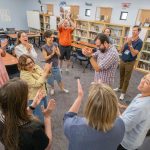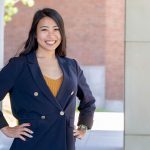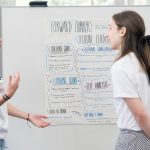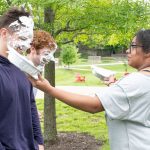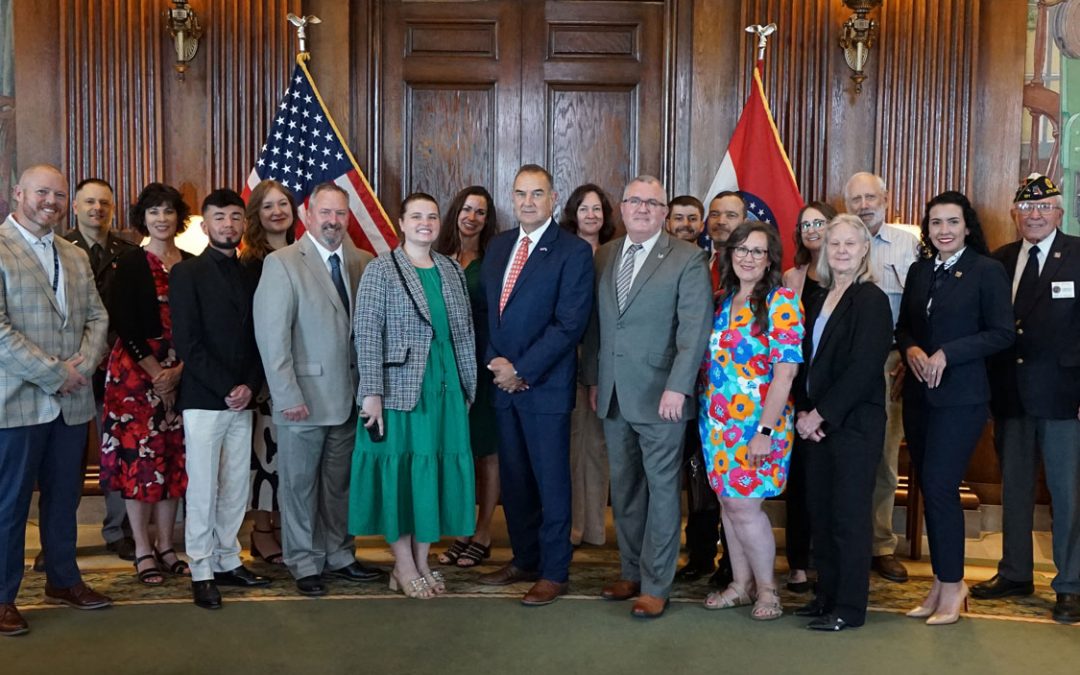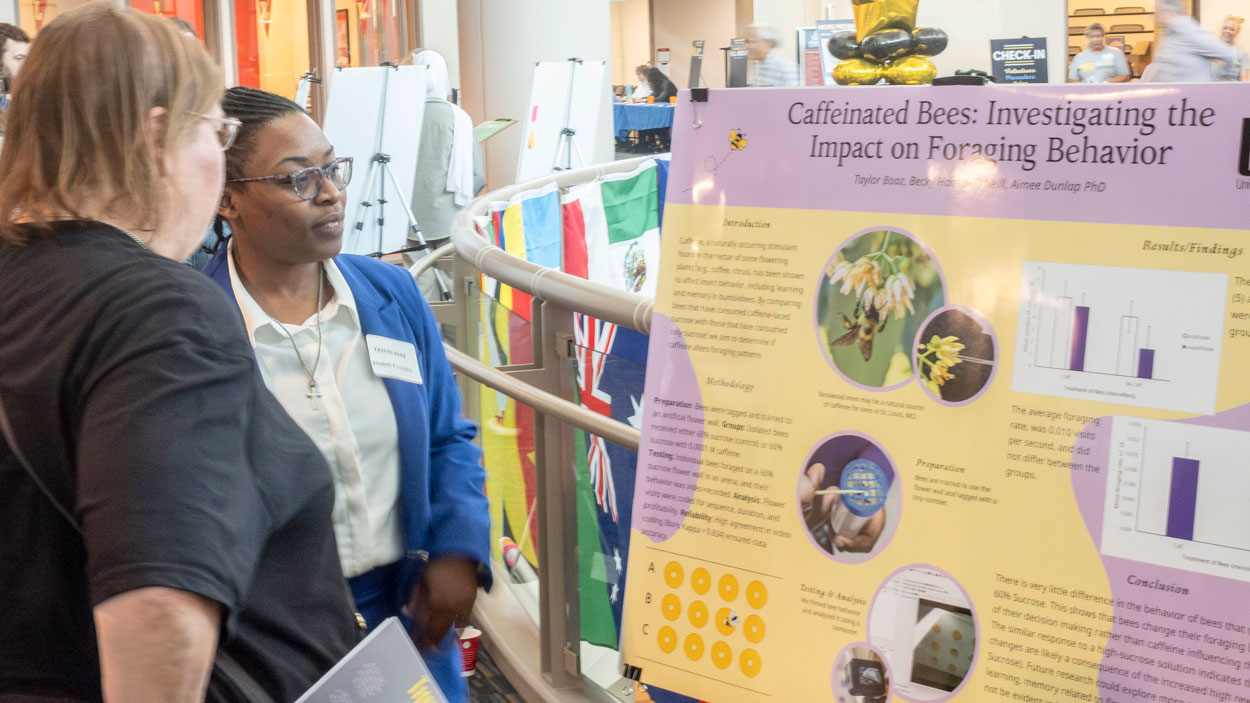
Biology major Taylor Boaz discusses her research on caffeinated bees at the Undergraduate Research Symposium. (Photos by Steve Walentik)
Taylor Boaz is majoring in biology with plans to go to medical school so she can care for children as a pediatrician.
But this semester, the University of Missouri–St. Louis junior has been concerning herself with different – much smaller – living creatures: bees.
Specifically, Boaz has been working in the lab of Associate Professor Aimee Dunlap and evaluating whether exposure to caffeine impacts the rates at which bees forage. She used an artificial flower wall and gave the bees doses of either caffeine or sugar water, then tested how well they foraged using video analysis.
She presented her work last Friday during the annual Undergraduate Research Symposium held on the third floor of the Millennium Student Center.
“I had a good time, and I just wanted to share my results,” said Boaz, who concluded there was no discernible impact from caffeine on foraging behavior.
Regardless of what those results were, the process of conducting research and learning how to convey it was important.
“Being a science major, there are going to be times where I’m going to have to present research or findings or whatever it may be,” she said. “It was good to be able to practice communicating in a setting that is understanding.
“Another reason is to be able to step out the box and not just isolate yourself to one specific thing. I want to be a pediatrician, so I wouldn’t be working with bees, but at least I can be able to say, ‘I did try this.’ I think that’s very important to try new things, even if you’re not going to be doing that pathway.”
Boaz was one of several students to receive special recognition for the quality of her work during a reception that followed the symposium on Friday afternoon.
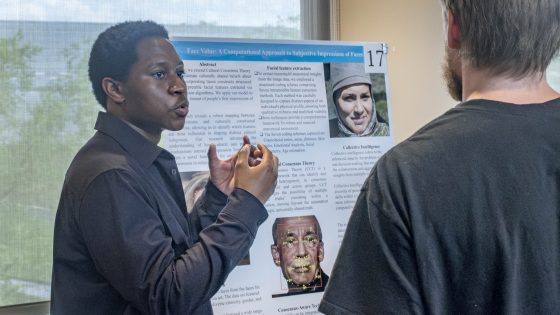
Information systems and technology major Kevin Kpankou explains his research on facial recognition at the Undergraduate Research Symposium.
She might have had a small edge over some of the more than 50 other undergraduate participants whose posters filled the MSC’s third-floor rotunda and roughly half of the Century Rooms. That’s because Friday wasn’t Boaz’s first time presenting. Last year, she shared research she did for a Pierre Laclede Honors College course in which she examined the power and influence of women in the Bible.
That speaks to the range of research that is on display each year at the Undergraduate Research Symposium.
“I think that those new to the event would be surprised by the variety of topics and presentations that are offered,” said Kate Votaw, an associate teaching professor who serves as UMSL’s undergraduate research coordinator and plays a lead role in organizing the symposium. “From talking with folks, I find that many people narrowly associate ‘research’ only with the natural sciences, and don’t get me wrong, we have those presentations, too. But to be honest, I always get a little more excited to offer students from the fine arts, humanities and lesser represented social sciences the opportunity to demonstrate their advanced projects as well. I am personally really proud of the span of topics.”
Kevin Kpankou, a junior major in information systems and technology, shared his research into how facial features influence first impressions of people. Working under the guidance of Assistant Professor Necdet Gurkan, Kpankou used computer vision to extract interpretable data about facial features – including craniofacial ratios, area, craniofacial distance, skin color, emotion analysis, facial symmetry and age estimation – and applied Cultural Consensus Theory to estimate culturally shared beliefs.
The research provides a novel framework for modeling the cultural consensus in subjective social judgments.
“There are different ways that this research can be applied,” Kpankou said. “First and foremost, if you’re developing a product and you want to target a specific subculture – say your product is meant for a certain type of person. Within our model, we can identify that subculture, see what they like, and see how your product can meet their demands.”
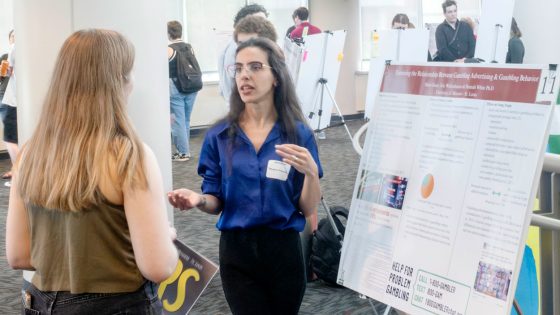
Biology major Ilkim Green discusses the results of a literature review she did on gambling advertising with Psychology Assistant Professor Hannah White.
Biology major Ilkim Green has been working with psychology master’s student Eric Wickenhauser and Assistant Professor Hannah White on a literature review examining the relationship between gambling advertising – which has become increasingly prevalent on television, across social media and inside sports stadiums and arenas – and its impact on gambling behavior.
“There are two main populations that are impacted by this – problem gamblers and young people,” she said while explaining her work. “For problem gamblers, the structures and strategies used in these advertisements really influence intentions to gamble, and we see that response impacting behavior. That means increased exposure to advertisements was associated with greater risk of gambling behavior.”
A growing number of UMSL students have taken an interest in geospatial technology and learning to use geographic information system – or GIS – tools to investigate issues. Among them are data science and analysis major Safa Altamimi and Grant Lewis, who is pursuing a geospatial certificate.
Both presented research they’ve been doing under the supervision of Geospatial Collaborative Director Reda Amer. Altamimi’s research, connected to an internship she’s had at the National Geospatial-Intelligence Agency, examined China’s influence over the mining in Africa. Lewis, meanwhile, studied critically low water levels in artificially made Gatun Lake near the Panama Canal in 2023-24 and the impact that has had on international trade moving through the canal. He also studied the growing trade influence of China, which operates two of the largest ports in the region and continues to make additional investments.
All four students described pursuing research opportunities to deepen their learning, and Altamimi said she was glad to challenge herself and step out of her comfort zone last Friday as she showed off her work.
That’s what Votaw hopes undergraduate students take away from their research.
“The research process is one very reliable way to answer the questions we all ask and those that could improve things the most,” Votaw said. “By getting students involved in the research process as undergraduates, they are able to see for themselves, through the high-impact experience of hands-on learning, the ups, the downs, the highs, the lows, and probably most importantly, the impact of answering questions using systemic and empirical processes.
“The last step in any research methodologies textbook is going to talk about the importance of sharing the results for reexamination and iterative growth in the field. I hope the URS provides our students with the chance to feel that sense of connection and contributions to what they are here to study.”



